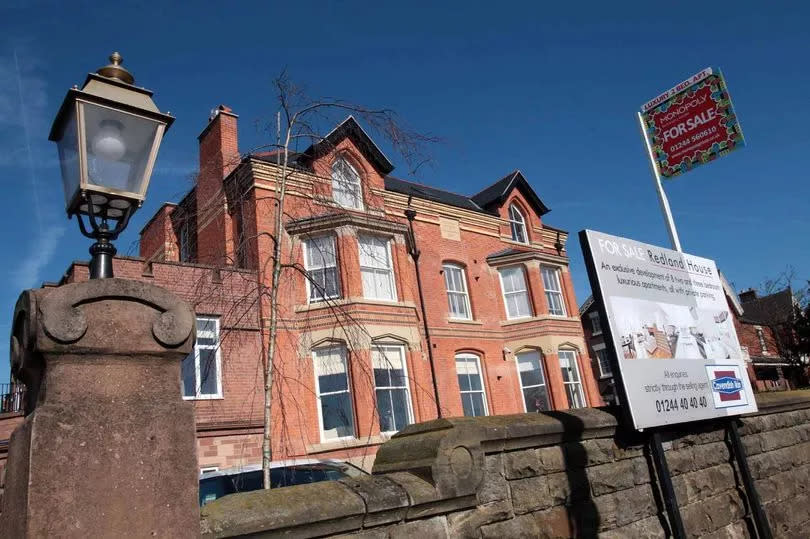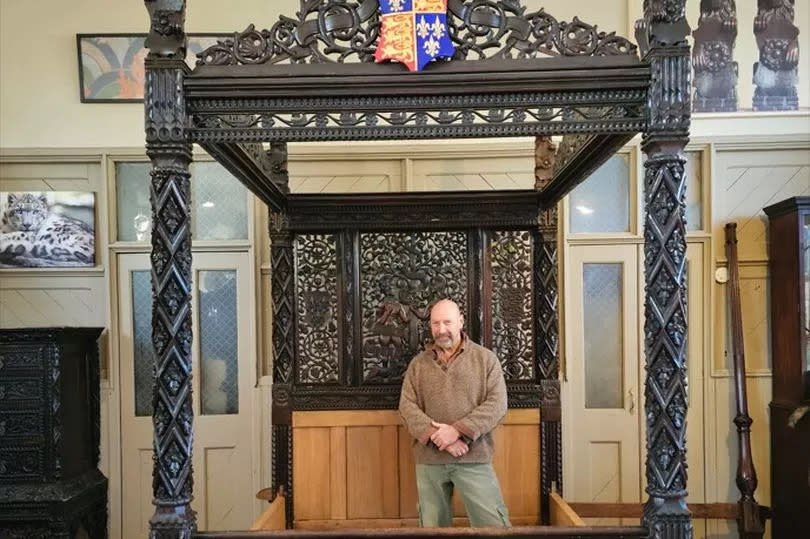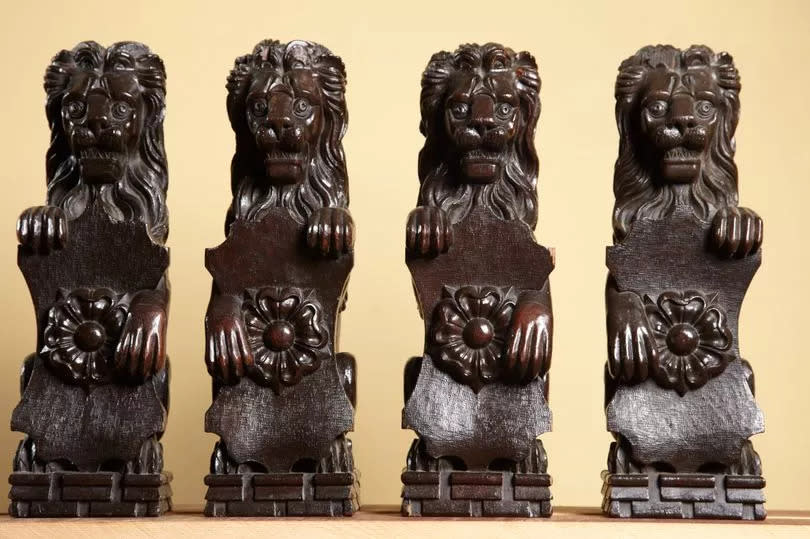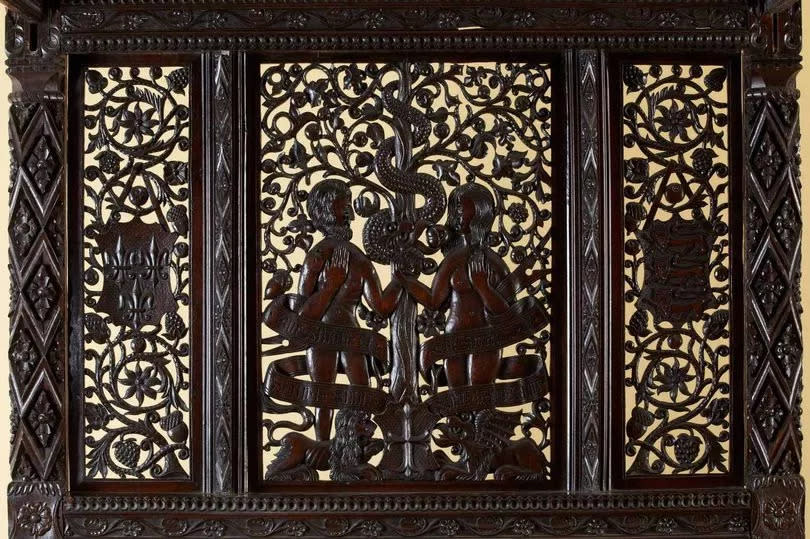How bed where King Henry VIII was conceived found 'dumped' in Chester car park

Chester may be bursting with historical artefacts, but one of the most extraordinary discoveries ever to be made in the city came about quite out of the blue when a former hotel was being renovated. Builders clearing out the former Redland House Hotel on Hough Green in Chester were tasked with moving a four poster bed that had once taken pride of place in the hotel's honeymoon suite.
On a chilly autumn day back in 2010, this elaborately carved oak bed, thought to date back to the 19th century, was taken apart and unceremoniously left in the car park of this former 19th century industrialist's house, ready to be collected by an auction house. Rain may well have fallen on the sad looking dismantled bed as people more than likely walked past without giving it a second glance.
But little did they know that the bed was to make national news when its true provenance was discovered. It was snapped up at auction by four poster bed collector Ian Coulson, who discovered it was actually much older than previously thought - and it turned out to be none other than the marital bed of Henry VII and his wife Elizabeth of York.
READ: £20m king's bed found in car park Henry VII's bed discovered at Hough Green hotel
READ: Tests prove bed dumped in Chester car park could be worth £20m DNA tests prove royal provenance of Hough Green find
Henry VII defeated Richard III in the Battle of Bosworth Field and whose skeleton was found in the Leicester car park in 2012. The bed is thought to have been commissioned almost immediately after Henry VII’s accession, to celebrate his marriage to Elizabeth of York and the end of the War of the Roses.
Named the Paradise State Bed, it could even have been the place where Henry VIII was conceived and where Henry VII's eldest daughter, Margaret Tudor, who was Queen of Scotland from 1503 to 1513, was born.
Ian Coulson, who is based near Hexham in Northumberland, paid £2,200 for the bed, having not even seen it. When it arrived, he set about unpacking and examining what was listed in the auction house catalogue as a 19th century Victorian gothic revival bed.
And he told CheshireLive that the moment he saw it he knew it was much older than was previously thought. He set about investigating the provenance of the ornate bed, and was stunned when he learned of its true heritage.

This extraordinary artefact was built to be taken apart and carried around the country long before the advent of flat pack furniture.
Ian Coulson told CheshireLive that he didn't know how long the bed had been in the former Redland House Hotel when he spotted it while searching lots on Chester-based website www.ukauctioneers.com back in 2010.
He said: "I absolutely love the bed and I'm very happy to be the guardian of it. I'm pleased it came my way. It was a real goosebumps moment when I started to realise what it was.
"It's taken around 13 years of my life now to research it and it is absolutely incredible. There are so many layers to it. It's not like something unearthed out of the ground.

"It's had a life as a bed for 500 years. It has been used and revered for most of that time, probably until the early 1900s when its identity has been lost.
"I have had people get in touch to say they spent quite a lot of time in that room at the Redland House Hotel and one man on business spent months sleeping in that bed. The room with the bed in was said to be incredibly spooky.
"We have documentation. It was a ceremonial bed and it is listed once in the Whitehall Inventory and in Henry VIII's post mortem inventory. It's described as being painted and guilded with ultra marine blue on the headboard, which was more expensive than gold.
"There are four heraldic lion finials which are screwed on top and they appear to have been threaded in and out many times.
"There would have been five or six layers of mattresses on it, including goose and swan feather mattresses.
"Lots of historic royal beds were stored at Windsor Castle and used as a tourist attraction. It was inspected by the Guardian of the Bed and would have been sprinkled with Holy Water before the King went to bed.
"I don't know how long the bed had been in the hotel but it was bought by a lady from there who wanted to create a honeymoon suite. She purchased it from an antiques dealer, Eric Davidson.
"She'd called in looking for something suitable for a honeymoon suite. The bed was flat packed and she drove off in a Volvo estate and I believe there was even a near miss when her car was hit.
"I got the bed from an auction. It had been left lying in the car park of the hotel for the auction house to collect.
"The bed was described as a Victorian gothic revival bed. I hadn't had time to go and view it as I had just arrived back in the country from America that day. I just took them at their word. Nobody expects a Royal Tudor bed to just turn up.
"It wasn't until I saw it in person that I realised there is something more to this, with the level of decay, repair and oxidisation. It was riddled with woodworm in places and there were areas of rot.
"It had quite a lot of science done on it, with the dendrochronology tests giving conflicting results. The DNA tests on the timber were carried out in Hamburg by the people who worked on the timbers from the Mary Rose.

"Tests on the paint also showed a fantastic and broad range including red iron oxides and ultra marine blue which was indicative of a Royal commission as it was very expensive."
Asked about the possible value of the bed, Ian Coulson said: "I have no idea. I think it's cultural value is more important than any monetary value. Jonathan Foyle said this is like the Rosetta Stone of Tudor artefacts."
Talking about the bed's travels around the country, Ian said he believed it had been gifted by Elizabeth I to the former Lord Mayor of London, Sir Nicholas Mosley, as a reward for his services to the Queen. Bestowing Royal beds was a known practice as a way of rewarding loyalty.
Sir Nicholas Mosley moved back up to Manchester on his retirement and so this would explain the bed's journey up north. The bed is then thought to have moved around a number of Mosley family properties.
It is also thought to have gone on to one of the family's residences in Staffordshire where Ian Coulson said it came to the attention of Victorian architect and faker George Shaw, who produced a range of fake Tudor beds inspired by it.
And in terms of what sort of decadent fabrics would have been used to adorn the royal bed, Ian said that sadly they have no evidence of the original draping scheme. They do know, however, that the bed would have been in the Painted Chamber which was part of the medieval Palace of Westminster, with records showing it was there on January 18 1486, which was the date of Henry VII's marriage to Elizabeth of York.
He said it would not originally have had its own drapes as there was an external wall of drapes in the Painted Chamber. Drapes were said to have been added later.
Grosvenor Museum curator Liz Montgomery said it was wonderful that the bed was discovered in Chester and she wished the museum team had spotted it and purchased it at the time.
Liz said: "It's an absolutely fascinating story and it's wonderful that this bed was found in Chester. The people doing the research into its provenance are experts in their field.
"If they consider it viable that it is Henry VII's bed then they are the top people who would know. They are the best in the country.
"It was listed in the auction catalogue as a 19th century gothic revival four poster bed. It would have had a lot of time to travel around and it's exciting to know that it ended up here in Chester.
"It was then bought at auction by a four poster bed specialist in Northumberland. Its provenance had been lost over time.
"It's an oak bed and very typical of the sort that elite medieval people would have used. It has a really big and tall headboard with intricate carved panels, with Adam and Eve in the centre and shields on either side.
"At the foot of the bed there are more carved panels and on top of each of the four posts there are little lions holding shields and what looks like the flag of St George.
"It was typical for very important people to carry their beds with them or for the family they were staying with to have special furniture created for when royalty were coming to stay.
"It would have had a horsehair mattress and bolsters, with lots of cushions and pillows, with fine linens. In Tudor times fabrics were considered an important part of people's household furnishings and they were handed down in various families in wills and infantries.
"The fabrics used would have been rich colours such as maroons and purples, with gold and silver thread. Sometimes velvet fabrics were used.
"I've dug out of the museum's records that the bed includes an inscription from a special Bible called the Matthew Bible printed in 1537. It reads 'The stinge of death is sinne. The strength of sinne is the lawe'."
Liz explained that the biblical carvings of Adam and Eve were depicted as Henry VII and his wife Elizabeth of York.
"There are also lots of symbols of fertility such as acorns, bunches of grapes and strawberries which were quite common in the Tudor period," she added.
Commenting on the fact that it ended up in Chester, Liz said: "It's a shame we didn't know it was there. We could have got it for the museum's collection. There aren't many links with Henry VII and Henry VII in Chester other than the obvious dissolution of the monasteries and lots of religious institutions were created, such as Chester Cathedral, which used to be St Werburgh's Abbey
The bed's true provenance was uncovered after two years’ extensive research, which confirmed it is the earliest royal bed in the country and one of the most significant artefacts of early Tudor history.
DNA tests proved the Royal provenance of the bed which went on display at Ann Boleyn's former residence of Hever Castle in Kent back in 2015.

The bed went on display in Auckland Castle, County Durham in 2014 and Ian Coulson said he is planning to put in on display again next year, although he could not share any other details at this stage.
"The hope is to put on an exhibition with the genuine article next year but this is still in the embryonic stages," Ian added.
The bed has also been the subject of a BBC4 documentary, Secret Knowledge: The King’s Lost Bed, presented by historian Dr Jonathan Foyle, who carried out much of the research into the bed's origins.
DNA tests have backed up the story of the bed's provenance. which could mean national newspaper reports suggesting the bed is worth £20m are correct.
TV historian Dr Jonathan Foyle said DNA testing of the timber proved that all samples are European oak and of a sub-species ‘typical of the origin of the finest, slow-grown oak imported by the medieval elites’. Dr Foyle said the age of the bed is revealed by the remains of its historic paintwork.
“Under the varnish, traces of late medieval decoration have been found,” he has previously explained.
The medieval bed also featured in an exhibition in 2015 called A Bed of Roses. It took place at Hever Castle in Kent, which is the childhood home of Anne Boleyn, Henry VIII’s second wife.
A book all about the bed - The Marriage Bed of Henry VII and Elizabeth of York - A Masterpiece of Tudor Craftsmanship - has also been written by Peter N Lindfield.
NEWSLETTER: Sign up for CheshireLive email direct to your inbox here

 Yahoo News
Yahoo News 
